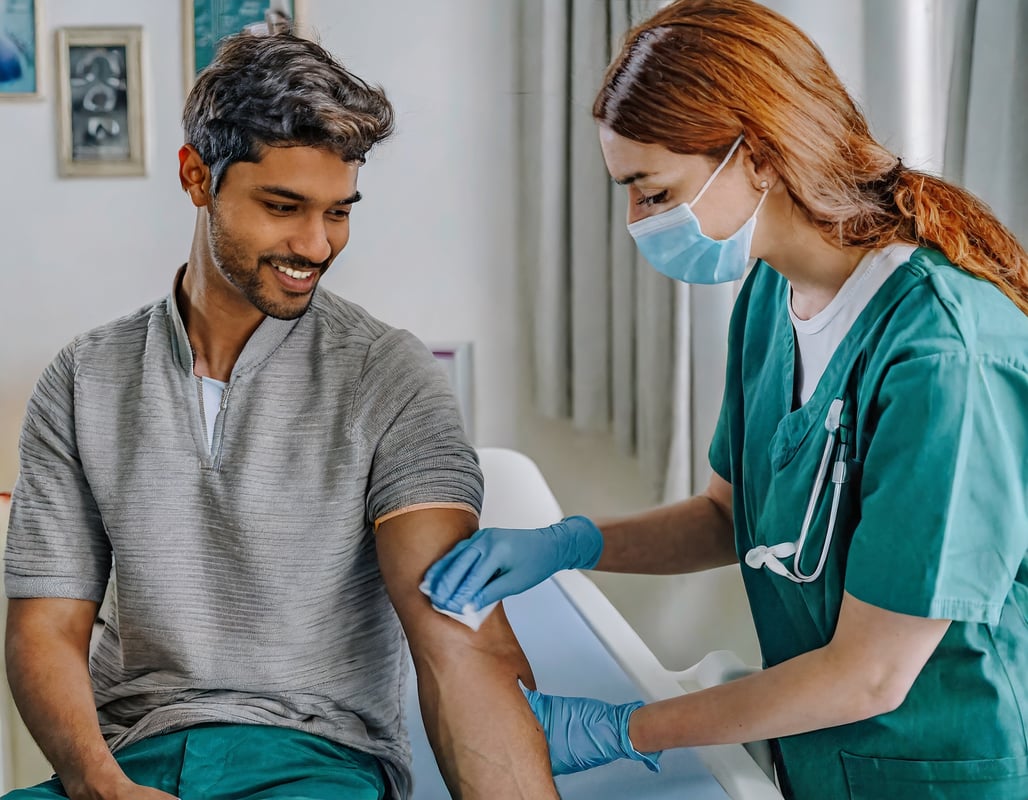Phlebotomy classes near me

According to the U.S. Centers for Disease Control and Prevention (CDC), someone in the United States requires blood or platelets every two seconds, resulting in over 14 million blood transfusions each year. However, only about 7 million people donate blood annually, highlighting a critical gap between supply and demand.
Phlebotomy is one of the fastest, most affordable entry points into healthcare. With training programs averaging just 4–12 weeks, costs between $500–$3,000, and a national salary of $44,390/year ($21.34/hour, BLS 2024), this certification offers quick access to stable jobs. Employment of phlebotomists is projected to grow 6% from 2024–2034. On Dreambound, you can compare 762+ programs and find upcoming phlebotomy classes near you.
At Dreambound, we help over 100,000 people find job training programs every month, so we know the ins and outs of all the different certifications out there. Phlebotomy is our most popular certification as of March 2024.
Here's why we like the phlebotomy certification over other allied health certifications here at Dreambound:
- Pays better than Certified Nursing Assistant, another popular allied health certification
- Top 2 most affordable and short certification. Check out EKG Technician training for our other favorite. Classes may range from $500 to $2,000.
- Fully online training (optional in-person externship). You read that right! It's surprising, but some of your phlebotomists who've drawn your blood likely were trained online as well. That's why phlebotomy programs are able to be affordable.
- Opportunities to be a travel phlebotomist or work part-time
- It's patient-facing but doesn't burn you out like other patient-facing roles might. A lot of phlebotomists say it's very satisfying when they make a blood draw painless for a patient who has previously had a bad experience
- Very interesting from a clinical perspective. Get to draw blood and learn about diagnostics
- Get your foot in the door in healthcare
Phlebotomist Salary
The salary of a Phlebotomist can vary depending on factors such as experience, location, and the employing facility. According to the BLS, the mean annual wage of phlebotomists in May 2023 was $41,810, and the mean hourly wage was $20.10. The median annual salary for phlebotomists in May 2022 was $40,580, at which half earned more and half made less. The median hourly wage was $19.51.
How to Renew Your Phlebotomy Certificate
Renewing a Phlebotomy certificate typically involves completing continuing education units (CEUs) and paying the renewal fee. Specific requirements may vary depending on the certification agency and state regulations. A phlebotomy certification typically lasts for two years, and it is important to remember to renew your license in order to continue practicing this rewarding profession.
Phlebotomist vs. Medical Assistant
Phlebotomists specialize in drawing blood from patients for diagnostic testing, transfusions, or donations. They are trained in venipuncture techniques and must follow strict protocols to ensure the accuracy and safety of the blood collection process. On the other hand, Medical Assistants have a broader scope of responsibilities. They perform clinical tasks, such as taking vital signs, preparing patients for examinations, administering injections, and administrative duties, like scheduling appointments, managing medical records, and coordinating with insurance companies.
Phlebotomy Classes by City
In order to help you find a phlebotomy class, at Dreambound we've gathered the most comprehensive list of phlebotomy classes in the US. Below you can find a list of phlebotomy classes, organized by city. If you don't see your city listed, you can always search by zipcode.
- Phlebotomy classes near me in Albany
- Phlebotomy classes near me in Albuquerque
- Phlebotomy classes near me in Allentown
- Phlebotomy classes near me in Augusta
- Phlebotomy classes near me in Austin
- Phlebotomy classes near me in Bakersfield
- Phlebotomy classes near me in Baltimore
- Phlebotomy classes near me in Baton Rouge
- Phlebotomy classes near me in Birmingham
- Phlebotomy classes near me in Boston
- Phlebotomy classes near me in Bridgeport
- Phlebotomy classes near me in Buffalo
- Phlebotomy classes near me in Cape Coral
- Phlebotomy classes near me in Charleston
- Phlebotomy classes near me in Charlotte
- Phlebotomy classes near me in Chicago
- Phlebotomy classes near me in Cincinnati
- Phlebotomy classes near me in Cleveland
- Phlebotomy classes near me in Colorado Springs
- Phlebotomy classes near me in Columbia
- Phlebotomy classes near me in Columbus OH
- Phlebotomy classes near me in Dallas/Fort Worth
- Phlebotomy classes near me in Dayton
- Phlebotomy classes near me in Deltona
- Phlebotomy classes near me in Denver
- Phlebotomy classes near me in Des Moines
- Phlebotomy classes near me in Detroit
- Phlebotomy classes near me in Durham
- Phlebotomy classes near me in El Paso
- Phlebotomy classes near me in Fresno
- Phlebotomy classes near me in Grand Rapids
- Phlebotomy classes near me in Greensboro
- Phlebotomy classes near me in Greenville
- Phlebotomy classes near me in Harrisburg
- Phlebotomy classes near me in Hartford
- Phlebotomy classes near me in Houston
- Phlebotomy classes near me in Indianapolis
- Phlebotomy classes near me in Jackson
- Phlebotomy classes near me in Jacksonville
- Phlebotomy classes near me in Kansas City
- Phlebotomy classes near me in Knoxville
- Phlebotomy classes near me in Las Vegas
- Phlebotomy classes near me in Little Rock
- Phlebotomy classes near me in Los Angeles
- Phlebotomy classes near me in Louisville/Jefferson County
- Phlebotomy classes near me in Madison
- Phlebotomy classes near me in McAllen
- Phlebotomy classes near me in Memphis
- Phlebotomy classes near me in Miami
- Phlebotomy classes near me in Minneapolis
- Phlebotomy classes near me in Nashville
- Phlebotomy classes near me in New Orleans
- Phlebotomy classes near me in New York
- Phlebotomy classes near me in North Port
- Phlebotomy classes near me in Oklahoma City
- Phlebotomy classes near me in Omaha
- Phlebotomy classes near me in Orlando
- Phlebotomy classes near me in Oxnard
- Phlebotomy classes near me in Palm Bay
- Phlebotomy classes near me in Philadelphia
- Phlebotomy classes near me in Phoenix
- Phlebotomy classes near me in Pittsburgh
- Phlebotomy classes near me in Poughkeepsie
- Phlebotomy classes near me in Providence
- Phlebotomy classes near me in Provo
- Phlebotomy classes near me in Raleigh
- Phlebotomy classes near me in Richmond
- Phlebotomy classes near me in Salt Lake City
- Phlebotomy classes near me in San Antonio
- Phlebotomy classes near me in San Bernardino/Riverside
- Phlebotomy classes near me in San Diego
- Phlebotomy classes near me in San Jose
- Phlebotomy classes near me in Scranton
- Phlebotomy classes near me in Springfield
- Phlebotomy classes near me in St. Louis
- Phlebotomy classes near me in Stockton
- Phlebotomy classes near me in Tampa
- Phlebotomy classes near me in Toledo
- Phlebotomy classes near me in Tucson
- Phlebotomy classes near me in Tulsa
- Phlebotomy classes near me in Worcester
How to Become a Phlebotomist
We know taking the first step to becoming a phlebotomist can be scary. That's why we're trying to demystify the process by writing guides on how to become a phlebotomist. Since state processes or requirements may vary, we've written separate guides for each state:
- How to Become a Phlebotomist in Alabama
- How to Become a Phlebotomist in Alaska
- How to Become a Phlebotomist in Arizona
- How to Become a Phlebotomist in Arkansas
- How to Become a Phlebotomist in California
- How to Become a Phlebotomist in Colorado
- How to Become a Phlebotomist in Connecticut
- How to Become a Phlebotomist in Delaware
- How to Become a Phlebotomist in Florida
- How to Become a Phlebotomist in Georgia
- How to Become a Phlebotomist in Hawaii
- How to Become a Phlebotomist in Idaho
- How to Become a Phlebotomist in Illinois
- How to Become a Phlebotomist in Indiana
- How to Become a Phlebotomist in Iowa
- How to Become a Phlebotomist in Kansas
- How to Become a Phlebotomist in Kentucky
- How to Become a Phlebotomist in Louisiana
- How to Become a Phlebotomist in Maine
- How to Become a Phlebotomist in Maryland
- How to Become a Phlebotomist in Massachusetts
- How to Become a Phlebotomist in Michigan
- How to Become a Phlebotomist in Minnesota
- How to Become a Phlebotomist in Mississippi
- How to Become a Phlebotomist in Missouri
- How to Become a Phlebotomist in Montana
- How to Become a Phlebotomist in Nebraska
- How to Become a Phlebotomist in Nevada
- How to Become a Phlebotomist in New Hampshire
- How to Become a Phlebotomist in New Jersey
- How to Become a Phlebotomist in New Mexico
- How to Become a Phlebotomist in New York
- How to Become a Phlebotomist in North Carolina
- How to Become a Phlebotomist in North Dakota
- How to Become a Phlebotomist in Ohio
- How to Become a Phlebotomist in Oklahoma
- How to Become a Phlebotomist in Oregon
- How to Become a Phlebotomist in Pennsylvania
- How to Become a Phlebotomist in Rhode Island
- How to Become a Phlebotomist in South Carolina
- How to Become a Phlebotomist in South Dakota
- How to Become a Phlebotomist in Tennessee
- How to Become a Phlebotomist in Texas
- How to Become a Phlebotomist in Vermont
- How to Become a Phlebotomist in Virginia
- How to Become a Phlebotomist in Washington
- How to Become a Phlebotomist in West Virginia
- How to Become a Phlebotomist in Wisconsin
- How to Become a Phlebotomist in Wyoming
Exploration of Phlebotomy Versus Other Programs
Considering other programs? Read our guides on Phlebotomy versus other similar programs in field, providing a comprehensive overview to assist you in making the right choice for your career path.
- Acute Care Nursing Assistant vs Phlebotomy
- Caregiver vs Phlebotomy
- Chiropractic Assistant vs Phlebotomy
- CPR-BLS vs Phlebotomy
- Dental Assistant vs Phlebotomy
- Diagnostic Medical Sonographer vs Phlebotomy
- EKG vs Phlebotomy
- Emergency Medical Technician vs Phlebotomy
- First Aid vs Phlebotomy
- Healthcare Documentation Specialist vs Phlebotomy
- Hemodialysis Technician vs Phlebotomy
- Licensed Vocational Nurse vs Phlebotomy
- Massage Therapist vs Phlebotomy
- Medical Administrative Assistant vs Phlebotomy
- Medical Biller and Coder vs Phlebotomy
- Medical Transcriptionist vs Phlebotomy
- Healthcare Operator vs Phlebotomy
- PALS vs Phlebotomy
- Pharmacy Technician vs Phlebotomy
- Phlebotomy vs Physical Therapy Technician
- Phlebotomy vs Psychiatric Technician
- Phlebotomy vs Registered Nurse
- Phlebotomy vs Respiratory Therapist
- Phlebotomy vs Sterile Processing Technician
- Phlebotomy vs Surgical Technician
- Phlebotomy vs Veterinary Assistant
Online Classes to Consider
- Online Medical Assistant classes
- Online Phlebotomy classes
- Online EKG classes
- Online Pharmacy Technician classes
- Online Medical Assistant classes
Similar Classes to Phlebotomy
- Find Medical Assistant certification training here
- Find Medical Billing / Coding certification training here
- Find Patient Care Technician certification training here
- Find Sterile Compounding & IV Aseptic certification training here
Final Thoughts
Phlebotomy is a short, affordable healthcare training option that leads to stable, in-demand jobs. With online and local programs, you can get started quickly and earn above entry-level wages.
Ready to get started? Take the next step today and open the door to a stable, in-demand healthcare profession!

Justine Tacmo is part of the Growth team at Dreambound. He assists the organization by updating critical information so students receive the most up-to-date information for their desired trade schools. Besides, he has a passion for writing and expresses it through poetry, covering themes of life, love, and mental health, which is also his advocacy.



